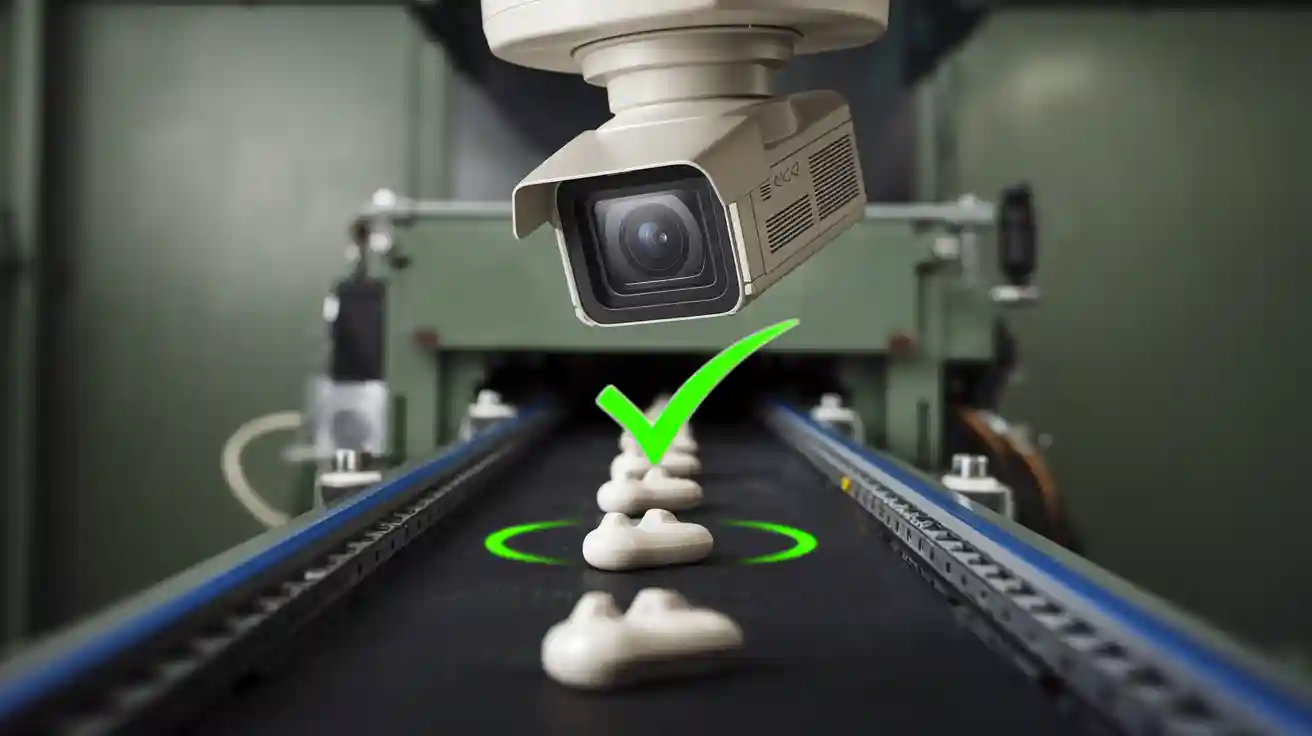
A type ii error machine vision system occurs when the system fails to detect a defect that is actually present, also known as a type 2 error or false negative. This type ii error can directly impact product quality and safety. In quality control experiments, researchers have observed that the prevalence of type ii error can affect up to 10% of inspected items, and even a 2% error rate can result in most rejected runs being false rejections.
- False negatives allow defective parts to pass inspection, which can compromise safety in industries like aerospace and medical devices.
- Missed defects may lead to recalls, damage to brand reputation, or even legal and regulatory penalties.
Companies should consider how type ii error machine vision system performance could influence their operations and the risks of undetected defects.
Key Takeaways
- Type II error happens when a machine vision system misses a real defect, letting faulty products pass inspection.
- Missed defects can harm product quality, cause costly recalls, and create safety risks in industries like aerospace and medical devices.
- Common causes of Type II error include poor data quality, unbalanced training data, and incorrect system sensitivity settings.
- Improving system sensitivity, using high-quality data, and optimizing algorithms help reduce Type II errors and improve defect detection.
- Regularly monitoring performance with metrics like recall and adjusting system settings keeps machine vision systems reliable and safe.
Type II Error Machine Vision System
Definition
Type ii error in a machine vision system means the system misses a defect that actually exists. In hypothesis testing, this error is called a false negative. The system fails to identify a problem, so a defective item passes inspection. Academic literature defines type ii error in visual inspection as a miss, where the system does not detect a defect even though one is present. This stands in contrast to a type i error, which is a false positive, where the system incorrectly flags a good item as defective.
In hypothesis testing, type i and type ii errors represent two sides of decision-making mistakes. Type i error means a false positive, while type ii error means a false negative. Both errors can impact the reliability of a machine vision system, but type ii error often poses a greater risk in quality control because undetected defects can reach customers.
Empirical studies show that type ii error machine vision system performance can be measured using metrics like recall. For example, an automated visual inspection system for CBN inserts achieved a recall rate of 90%. This means the system missed 10% of actual defects, which directly reflects the frequency of type ii error. Other metrics, such as mean Average Precision (mAP) and mean Intersection over Union (mIoU), help quantify how well the system detects and locates defects. These numbers show that even advanced systems can still miss defects, making type ii error a critical concern.
Causes
Several factors contribute to type ii error in machine vision systems. These causes often relate to how the system processes data and makes decisions during hypothesis testing. Common causes include:
- Class Imbalance: When the training data contains more examples of non-defective items than defective ones, the model may learn to favor the negative class. This increases the chance of missing actual defects, leading to more type ii error.
- Model Bias and Data Quality: Poor calibration or low-quality data can cause the model to overlook defects. If the data does not represent all possible defect types, the system may not learn to detect them.
- Threshold Settings: The system uses thresholds to decide if an item is defective. Setting the threshold too high can increase type ii error because the system becomes less sensitive to small or subtle defects.
- Sensitivity Issues: Sensitivity, or the true positive rate, measures how well the system detects actual defects. Lower sensitivity means higher type ii error. In hypothesis testing, sensitivity equals one minus the probability of type ii error.
- System Limitations: Data drift, where the data changes over time, can reduce the system’s ability to detect defects. Data imbalance and lack of model experimentation also increase the risk of type ii error. Without regular updates and balanced datasets, the system may miss new or rare defect types.
Machine vision experts monitor performance metrics like recall and accuracy to track type i and type ii errors. Adjusting thresholds, improving data quality, and using advanced techniques like cost-sensitive learning can help reduce type ii error machine vision system rates. Regular monitoring and adaptive training ensure the system continues to perform well, even as data changes.
Real-World Impact

Quality Control
Type II errors in machine vision systems can create serious problems for quality control. When a system misses a defect, a faulty product can reach the customer. This failure can lead to customer complaints, returns, or even canceled orders. For example, a factory that produces screw heads with strict diameter requirements depends on machine vision to catch any that are too large or too small. If the system fails to detect these defects, the company may face costly recalls and lose customer trust. The Neyman-Pearson framework, which guides many quality control processes, shows that missing defects (Type II errors) can cause financial losses and harm a company’s reputation. Companies often set error rates to balance the risk of missing defects against the risk of a false positive, which occurs when a good product is incorrectly flagged as defective.
Quality control teams must monitor error rates closely. They should adjust system settings to reduce missed defects and protect product quality.
Safety Risks
Type II errors do not only affect profits. They can also put people at risk. In industries like aerospace, automotive, or medical devices, a missed defect can lead to equipment failure or injury. For example, if a machine vision system fails to spot a crack in an airplane part, the part could fail during flight. This risk makes it important for engineers to design systems that catch as many defects as possible. Safety standards often require strict testing and regular system updates to keep error rates low.
- Missed defects can cause:
- Product recalls
- Equipment breakdowns
- Safety incidents
Companies that use machine vision must take these risks seriously. They need to invest in better data, improved algorithms, and regular system checks to keep people safe and products reliable.
Reducing Type II Error
Minimizing type ii error in machine vision systems requires a strategic approach. Engineers and quality teams must address system sensitivity, data quality, and algorithm optimization. These steps help balance type i and type ii errors, which is essential for reliable hypothesis testing and effective defect detection.
System Sensitivity
System sensitivity plays a key role in reducing type ii error. Adjusting detection thresholds can make the system more likely to catch true defects. For example, tuning camera angles and selecting the right sensor size can improve image quality and detection rates. In one experiment, a DenseSSD model maintained high detection accuracy across different camera angles, with mean average precision values above 93%. This shows that optimizing sensitivity parameters, such as camera position and exposure, leads to better detection performance and fewer missed defects. Increasing sample size and enhancing statistical power also lower the chance of type ii error during hypothesis testing.
Data Quality
High-quality data forms the foundation of accurate machine vision systems. Teams should define defects and features clearly, build comprehensive image databases, and use proper lighting techniques. Consistent material handling and ambient light control further improve image acquisition. These practices help the system learn to distinguish between defective and acceptable parts, reducing both type i and type ii errors. Gauge Repeatability and Reproducibility studies confirm that improvements in data quality lead to real reductions in false negatives, not just measurement errors.
Algorithm Optimization
Refining algorithms directly impacts the balance between type i and type ii errors in hypothesis testing. Advanced models, such as those using artificial intelligence, have shown dramatic improvements in detection accuracy. For instance, AI-based systems in electronics manufacturing increased defect detection by 25% and reduced inspection errors by over 90%. The table below highlights some key improvements:
| Industry / Metric | Improvement / Statistic | Impact / Interpretation |
|---|---|---|
| Electronics Manufacturing | 25% increase in defect detection accuracy | Improved quality and reduced faulty products |
| General Defect Reduction | 99% reduction in defective products | Significant waste reduction and quality assurance |
| Object Detection Performance | Recall: 100%, F1 Score: 92.02%, Accuracy: 98.5% | High reliability and precision in defect identification |
Optimizing algorithms, improving data annotation, and collaborating with vendors for tailored solutions all contribute to reducing type ii error. Teams must regularly evaluate system performance using metrics like recall and F1 score to ensure ongoing improvement. Striking the right balance between type i and type ii errors remains crucial for optimal system performance in hypothesis testing.
Understanding and reducing type II error in machine vision systems remains vital for quality and safety. Teams can improve inspection reliability by adjusting system sensitivity, enhancing data quality, and refining algorithms. Regular evaluation helps maintain strong performance. Key metrics that reflect progress include:
- Recall, which shows how well the system finds true defects.
- F1-score, which balances recall and precision.
- AUROC, which gives a broad view of detection accuracy.
Ongoing adjustments ensure machine vision systems deliver reliable results.
FAQ
What is the main difference between Type I and Type II errors in machine vision?
Type I error means the system marks a good item as defective. Type II error means the system misses a real defect. Both errors affect inspection accuracy.
Why does Type II error matter in quality control?
Type II error allows defective products to pass inspection. This can lead to customer complaints, recalls, or safety issues. Companies must reduce these errors to protect their reputation.
How can teams measure Type II error in machine vision systems?
Teams often use recall or sensitivity metrics. High recall means the system finds most defects. Low recall signals more missed defects, which means higher Type II error.
Can adjusting detection thresholds reduce Type II error?
Yes. Lowering the detection threshold makes the system more sensitive. This helps catch more defects but may increase false positives. Teams must find the right balance.
What industries face the highest risk from Type II errors?
Industries like aerospace, automotive, and medical devices face high risks. Missed defects in these fields can cause equipment failure or safety hazards.
See Also
A Comprehensive Guide To Thresholding In Vision Systems
Analyzing How Machine Vision Detects Flaws Effectively
Exploring Image Processing Techniques In Vision Systems








